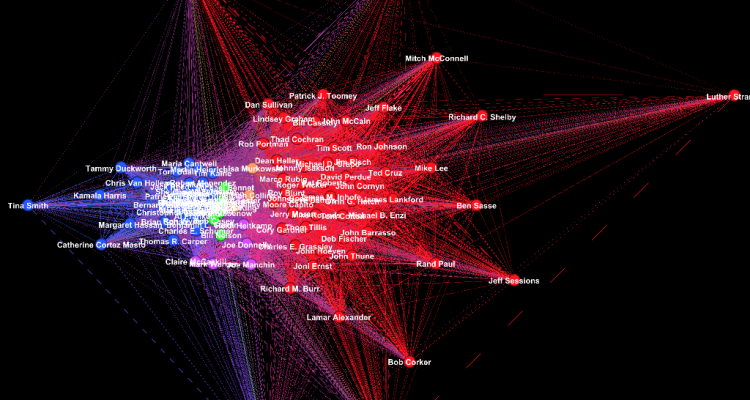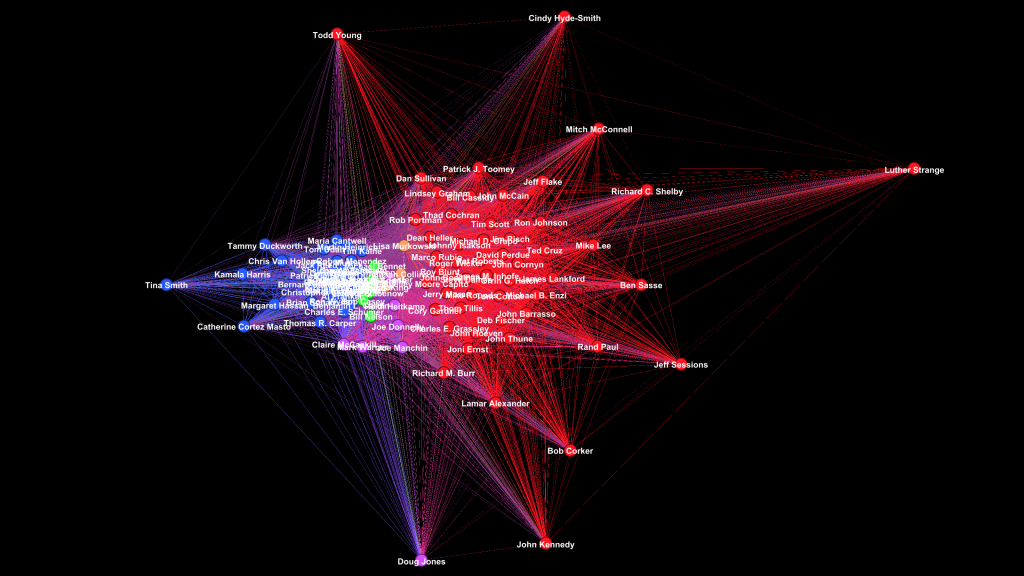By: Patrick W. Zimmerman
It is easy to arrive at the impression that partisanship trumps all. Much of the rhetoric and voting behavior of both houses of Congress in the second decade of the 21st century has done a lot to reinforce that notion. While party tribalism seems to be at a relative high point, with representatives and senators rarely breaking ranks, what about party unity? Congressional roll call votes tell a compelling story, but voting is not the only thing that legislators do. They also have to write the laws in the first place.
When we took a peek at communities in the House, we saw both a confirmation of two great hostile camps as well as a surprising variety of smaller networks. Does this also hold true for Senators who (due to their wider constituiencies and longer terms) are theoretically less subject to pressure from their citizens?
The question
What patterns show up in the bill-sponsoring behavior of the US Senators over the last 6 years? When analyzed as a social network (with a cosponsorship treated as an unweighted relationship), do any distinct communities appear?
The short-short version
Most Senators write bills toeing the party lines, and the communities display far fewwer surprises that in the House.
Communities that do show up tend to be right about where you’d expect: in distinct ideological slots between the two party establishments. There are three non-mainstream groups, all arrayed between the political center-left and the center (as measured by median DW nominate score of their members). They include the usual suspects for potential cross-party voting: Susan Collins (R-ME), Lisa Murkowski (R-AK), Claire McCaskill (D-MO), Joe Manchin (D-WV), Joe Donnelly (D-IN), Doug Jones (D-AL), and the like.
The results
Out of 104 Senators during the 2013-2018 period who have cosponsored at least one bill, there were 5,346 connections between them (combinations of reps who had cosponsored at least one bill together.
When graphed using Gephi’s ForceAtlas 2 algorithm and a modularity score applied, two tight blocs (the parties) and three identifiable communities between them appear.
When viewing the graph, two representatives that are closer together (and connected by a line, representing cosponsored bills) are more closely related. The limits of space will mean that a couple of random nodes ended up close together, but for the most part closer to the group = more closely related to the establishment.
The Senate breaks down pretty much as you’d expect, though it’s mildly surprising that the more extreme wings don’t really show up in bill sponsorship, just like they didn’t in the House. Kamala Harris, Elizabeth Warren, and Bernie Sanders stand out if one looks at their voting records (as do Mike Lee, Ted Cruz, and Rand Paul), but not so much with their bill cosponsorships.
- Red – establishment Republicans.
- Blue – establishment Democrats.
- Purple – The Blue Dog Democrats. Joe Manchin, Heidi Heitkamp, et. al.
- Orange – A small bipartisan group consisting of Susan Collins, Lisa Murkowski, and Angus King.
- Green – Rust Belt Dems – a group of moderate Democrats mostly from the Upper Midwest.
Here’s a table with all the details, including number of bills introduced, number of members, success with legislation, and partisan lean (DW nominate score, which runs from -1 radical left to +1 radical right).
Mouseover for details.
…and here’s the membership of each group.
Mouseover for details.
As in the House, the big party establishments dwarf the little sub-communities in size and number of bills introduced, though not really in efficiency. All three smaller communities have been more effective than the Democrats at getting bills passed, though that’s pretty much impossible to disentangle from the fact that the Republicans have controlled the Senate for this period and all three communities are to the right of the main body of Democrats.
Want to know who your Senator has been working with? Select a name from the drop-down menu to see how many bills they’ve cosponsored.
Mouseover for details.
What next?
So there are these bill-sponsoring cliques developing in each house of Congress. How has that changed over time (say, by administration or by 2-year period)


No Comments on "Congressional cosponsorship community detection: Which Senators actually work together?"